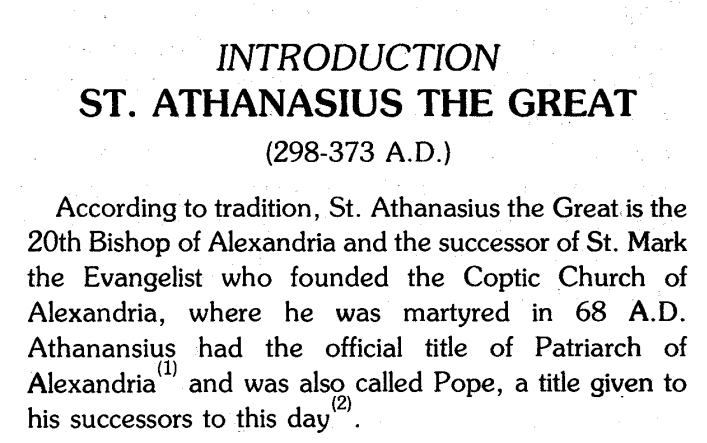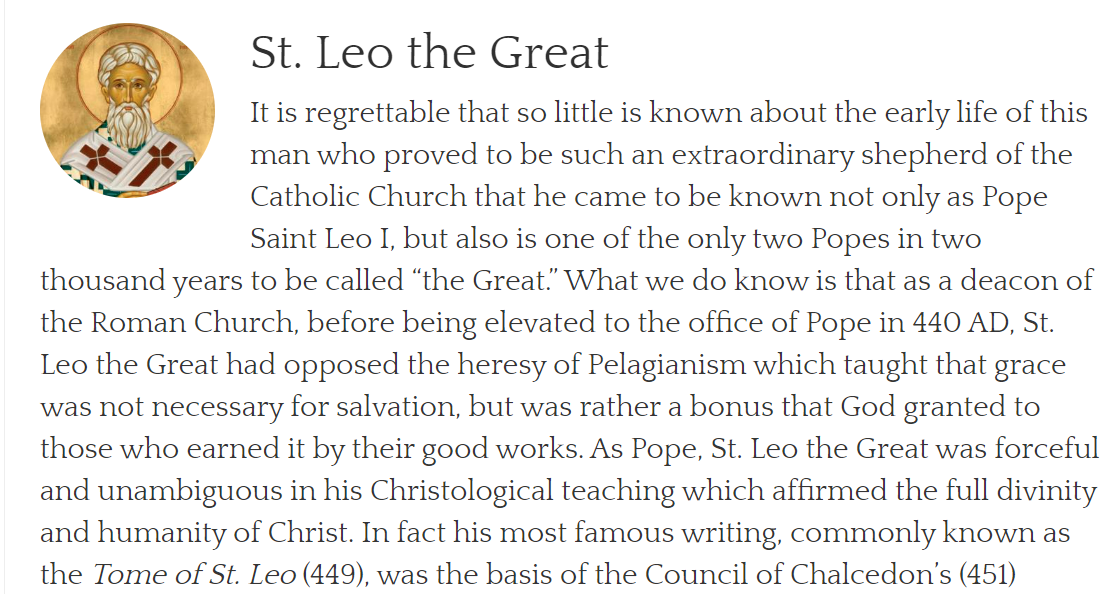Pope Was Not A Formal Title Until the 5th Century
As we’ve covered in the past chapter, the Papacy did not exist in the first four hundred years of Christianity and neither did the pre-eminence of the Roman bishop. So, why are there Early Church writings referring to Roman bishops as Popes then? This is actually a pretty benign point to dispute, but the term Pope, being Latin for father, was actually used refer to bishops of multiple offices repeatedly in the Early Church.
Among them was Saint Cyprian, occasionally referred to as Pope by his congregation in Carthage and much more prominently, Saint Athanasius of Alexandria, referred to as Pope by the members of the Early Church in Africa (Gonzalez, 2010).

This is especially prudent, because Pope Athanasius was actually present as a bishop in the Council of Nicaea, playing a prominent part in condemning the Arian heresy. This meant that he would still be considered a valid part of the proto-Catholic church. Not only that, but he would become a confidante to Constantine that was integral to keeping Arian from worming his way back into the Roman Catholic Church.
The reality was, that the church of Alexandria, much like the churches in Antioch and Jerusalem, were traditionally elevated to being at least equal with the church of Rome. This is irrefutably demonstrated in Canon 6 of the Council of Nicaea:
“Let the ancient customs in Egypt, Libya, and Pentapolis prevail, that the Bishop of Alexandria have jurisdiction in all these, since the like is customary for the Bishop of Rome also. Likewise in Antioch and the other provinces, let the Churches retain their privileges.”
In fact, this equality was so well established that when the Great Schism occurred in the eleventh century, the Eastern Orthodoxy would actually excommunicate the Roman Catholic church, partially on the grounds of their claim to primacy:
“The Great Schism came about due to a complex mix of religious disagreements and political conflicts. One of the many religious disagreements between the western (Roman) and eastern (Byzantine) branches of the church had to do with whether or not it was acceptable to use unleavened bread for the sacrament of communion. (The west supported the practice, while the east did not.) Other objects of religious dispute include the exact wording of the Nicene Creed and the Western belief that clerics should remain celibate.
These religious disagreements were made worse by a variety of political conflicts, particularly regarding the power of Rome. Rome believed that the pope—the religious leader of the western church—should have authority over the patriarch—the religious authority of the eastern church. Constantinople disagreed.
Each church recognized their own leaders, and when the western church eventually excommunicated Michael Cerularius and the entire eastern church. The eastern church retaliated by excommunicating the Roman pope Leo III and the Roman church with him.”
Sources: https://www.britannica.com/topic/Roman-Catholicism and https://www.nationalgeographic.org/thisday/jul16/great-schism/
The True Founding of the Papacy
Believe it or not, the jump from the proto-Catholic church to the Roman Catholic church as we know it today would actually occur in about one generation. This would be under the reign of Saint Leo, a man who enacts the single most drastic power shift of Roman Catholicism this side of Constantine.
Speaking of Constantine, Leo shared more than a few similarities with the first “Pontifex” of the Roman church. You see, during his residence as Bishop of Rome, Leo had already made a name for himself for his prestigious background in Christian apologetics. He was largely famous for shutting down several heretical schisms in the Eastern Empire:

While already respectable, Saint Leo would become legendary not due to successes in theology, but in war. Leo was the presiding bishop of Rome during the time that the Huns had made their second attempt on their thorough scourge of the Roman empire. They were doing pretty well for themselves, too. After robbing Constantinople at knifepoint, the opportunistic plunderers made their way westward with largely uncontested success.
After conquering Aquila, they turned their war path toward a relatively undefended Rome. This progression would become dicey for both sides, as the Romans and the Visigoths were the ones to defeat Atilla during his first conquest and he had already put his army through several battles to get there.
In spite of this, both the Eastern and Western branches of the Roman Empire shamelessly skirted away from the pillaging horde. However, Saint Leo rounded up his own forces and marched out to meet with Atilla himself.
I actually could not find a definitive case of what happened between Atilla and Leo, other than that it wasn’t war, but more of a diplomatic meeting. Whatever happened, the Huns retreated and left Rome unscathed. While Historians would later go on to explain this as a tactical move on Atilla’s part to recover his battered forces, a folk legend would quickly emerge detailing apparitions of Peter and Paul threatening Atilla at the meeting at the behest of Leo.
This win would put Leo in a very strong position for aggregating power. Not only did he prove himself to be more worthy of leadership than the Roman emperors themselves, but he also had the legend of Peter and Paul to exalt himself as a spiritual hero.
It was shortly after that Saint Leo, now dubbed Leo the Great, would introduce the idea of Rome being the pre-eminent church and its Bishop being its sovereign leader. How would he argue this?
With Matthew 16; the very same argument that Roman Catholics still use to defend the papacy to this day. Now, this wasn’t exactly anything new. Matthew 16 had been common knowledge to the Early Church since the beginning, but for hundreds of years not only was Rome only considered one of several powerful churches, but that Paul and Peter were celebrated equally for founding early churches.
On the doctrinal side, Matthew 16 says nothing about Peter being able to hand his power to his successors, and Acts irrefutably establishes Jerusalem as the pre-eminent epicenter of Christendom and Paul as the founder of the church in Rome.
How Leo Seized the Papacy
Well, Leo made three arguments. They weren’t exactly good arguments, but bishops had already aggregated a lot of power by then and Leo the Great was a bonafide folk hero, so who was going to argue with him?
- Leo produced the writings of Tertullian, which claimed that the early Roman church had registries detailing Peter as nominating Clement as his successor as Bishop of Rome. This could, of course, be easily refuted if the Roman registry of bishops wasn’t fabricated retroactively, as the current registry details Linus as Peter’s successor.
Also, why did he refer to a Montanist as a source of authenticity on Catholic teachings? I don’t know, and apparently neither did the Romans.
- Going back to Matthew 16, he rightly mentioned that Peter was granted the revelation of Jesus as the Christ by God Himself. Thus, by an admittedly large stretch, he argued that God Himself was always directing Peter and that Peter would be infallible. This would of course, be easily challenged by literally the remainder of Matthew, a sizable portion of Acts, and Galatians.
Unfortunately, many of the scriptures were in Greek and Hebrew, while the official language of Rome was still Latin, so the Laity was definitely not going to catch that.
- He established that by this special gift and through Jesus’ prayer, Peter was pre-eminent over all the apostles (sorry James) and was their spiritual source of strength. This of course, is only reasonable if we ignore the context of Jesus’ prayer, which was singling him out for needing additional spiritual guidance.
Anyway, Leo presented his arguments with admittedly impressive boldness and eloquence:
“And I,” he said, “tell you,” that is to say, just as my Father has manifested my divinity to you, so I make known to you your own prominence. “That you are Peter,” that is to say, although I am the indestructible rock, I “the cornerstone who make both things one,” I “the foundation on which no one can lay another,” you also are rock because you are made firm in my strength. What belongs properly to my own power you share with me by participation.
Jesus wished Peter who had been received into partnership in His undivided unity to be named what He Himself was, when He said: ‘Thou art Peter . . .’ Each apostle encountered the same danger through temptation from fear. All equally needed the help of divine protection, since the devil wanted to harass them all and to crush them all. Still, the Lord took special care of Peter and prayed especially for Peter.
It was as if the condition of the others would be more secure if the mind of their leader were not overcome. In Peter, therefore, the fortitude of all is reinforced, for the aid of divine grace is ordered in such a way that the firmness given to Peter through Christ is conferred upon the apostles through Peter.”
Now that Peter is established as the pre-eminent apostle with special power and authority from God himself, all he needed to do was tie Peter to Rome, hence Tertullian. With that piece of the puzzle found, Leo proudly declared Rome as being:
“A holy people, an elect nation, a priestly and royal city, become, through the see of Peter established here, the head of the world; ruling more widely now through the divine religion than it ever did by worldly dominion. Though enlarged by many victories, you have spread the authority of your rule over land and sea. What your warlike labours have obtained for you is less than what the Christian peace has brought you.”
And just like that, Leo established the Papacy in the Roman Empire. While this abrupt change was less than welcome in the Eastern Empire and Africa, Leo the Great had ultimately won over the Western Empire. While its start would be a little rocky, the Papacy was pretty much unchallenged by outsiders until the Great Schism, and its iron grip on political and spiritual affairs in its ever-growing jurisdiction would not be successfully clipped until the Reformation.
Sources: https://digitalcommons.andrews.edu/cgi/viewcontent.cgi?article=1007&context=aussj and https://www.ncronline.org/blogs/essays-theology/leo-greats-legacy-remains-challenge-church-today